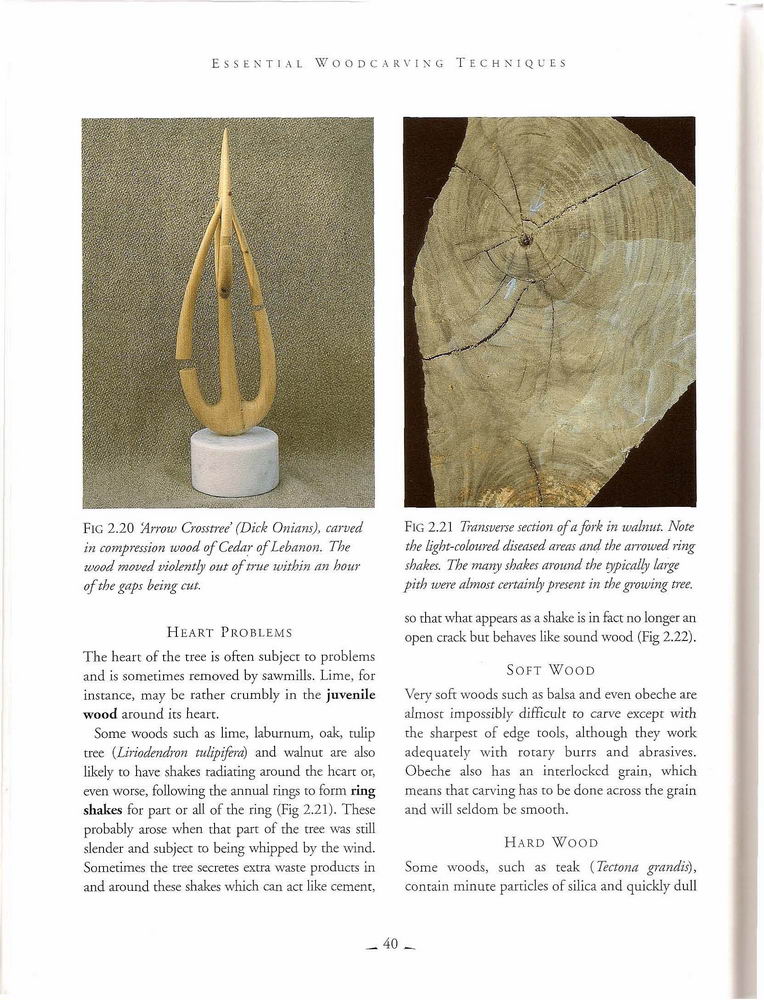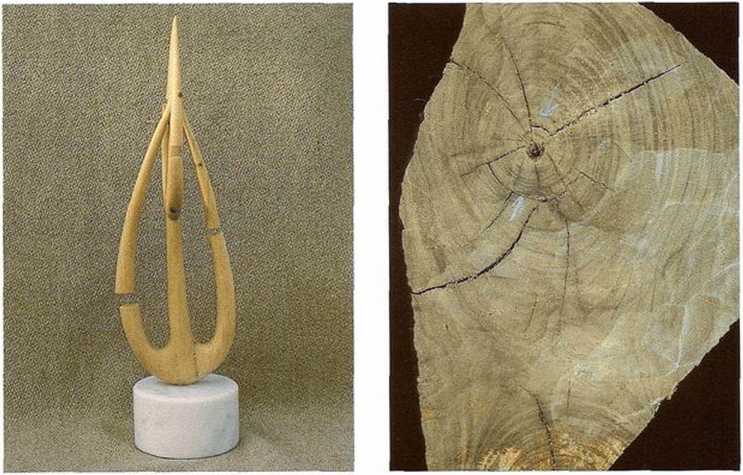essentÊrving°40

Essen tial Woodcarying Techniques

FlG 2.20 Arrow Crosstree (Dick Onians), carued in cotnpression wood of Cedar ofLebanon. The wood moved oiolentJy out of truć witbin an hour of the gaps being cut.
H li ART Pro BI. EMS
The heart of the tree is oftcn subject to problems and is sometimes reinoved by sawmills. LimÄ™, for instancc, may bc rather crumbly in the juvenile wood around its hcarc.
Some woods such as limÄ™, laburnum, oak, tulip tree (Liriodendron tulipifera) and walnut are also likcly to havc shakes radiating around the heart or, even worse, following the annual rings to form ring shakes for part or all of the ring (Fig 2.21). These probably arose when that part of the tree was still slendcr and subject ro being whipped by the wind. Sometimes the tree secretes extra waste products in and around these shakes which can act like cement,
Fig 2.21 Transuerse section ofa fórk in walnut. Notę the light-coloured diseased areas and the arrowed ring shakes. The ntany shakes around the typically large pith were almost certainly present in the growing tree.
so that whar appcars as a shakc is in fect no longcr an open crack but behaves like sound wood (Fig 2.22).
Soft Wood
Very soft woods such as balsa and even obeche are almost impossibly dilFiculc co carve except wirh the sharpest of edge tools, although they work adcquately with rotary burrs and abrasives. Obeclie also has an interlockcd grain, which mcans that carving has to be donc across che grain and will seldom bc smooth.
Hard Wood
Some woods, such as teak (Tectona grandis), contain minutÄ™ particles of silica and quickly duli
-40 _
Wyszukiwarka
Podobne podstrony:
essent?rving?68 Essen tial Woodcarving Techniques FlG 15.16 The fint cut into the serif on an M. Fig
essent?rving?34 Essen tial Woodcarying Techniques softwoods are evergreen and hardwoods are dcciduou
essent?rving?72 Essen tial Woodcarving Techniques although the temptarion ro use a router co set clo
essent?rving?16 Essen.tial Woodcarvmng Techsiques A clamp should be strong and have its heads in lin
essent?rving?18 Essen tul Woodcarning Techniques Fig 1.29 A bench holdfast in use. Fig 1.28 A univer
essent?rving?48 Essen tiał Woodcarving Techxiques Fig 3.5 From the bot tom: two correct chip cuts; t
essent?rving?50 Essen tial W o o d c a r vin g Techniques Fig 3.11 Making the stab aa at too shallow
essent?rving?58 Essen-tial Woodcarvig Techxiques Fig 4.10 Cu tti fig the cup. The gouge en ten the w
essent?rving?20 Essen tial Woodcarving T e c h n i q u e sChoosing the BestDlRECTION OF THE GRAIN Th
essent?rving?62 Essen tial Woodcary ing T e c h n i q u e s Top arm comes just Hal
essent?rving?72 Essen tial W o o d c a r vin g Techniques Alder {Alnus glutinosa) Pale yellow or pin
essent?rving?52 Essen’ tial W o o d c a r v i n g Techniques Fig 3.18 A No. 3 fishtail being used to
essent?rving?86 Essen tial W o o d c a r vin g Tech kiqu es fold. If these arc forgotten irrcversibl
essent?rving?04 E S S E N T I A L W O O D C A R V I N G T E C H N I Q V E S (Fig 9.20) bur could hav
leki nasenne0003 FigurÄ™ 20-3. Enhanetd GARA jynapric trans-mission. In ihc presence of GADA, ilic GA
essent?rving?79 ABOUT THE AUTHOR Dick Onians, bom in 1940 in a house fuli of books, folk carvings an
essent?rving?30 Essen ti al Woodcarving Techniques Fig 2.4 A piece of Southern yeUow pine. The dark
więcej podobnych podstron